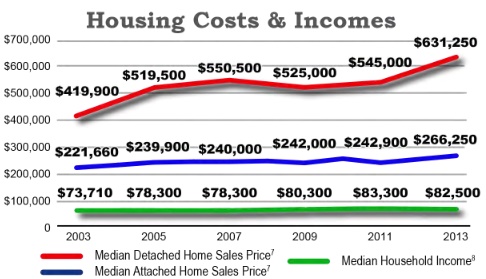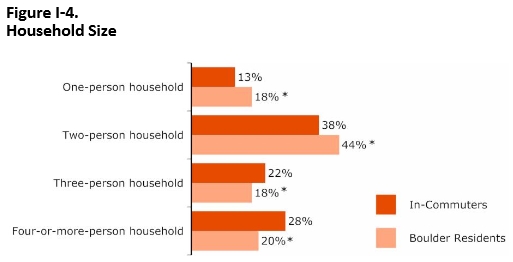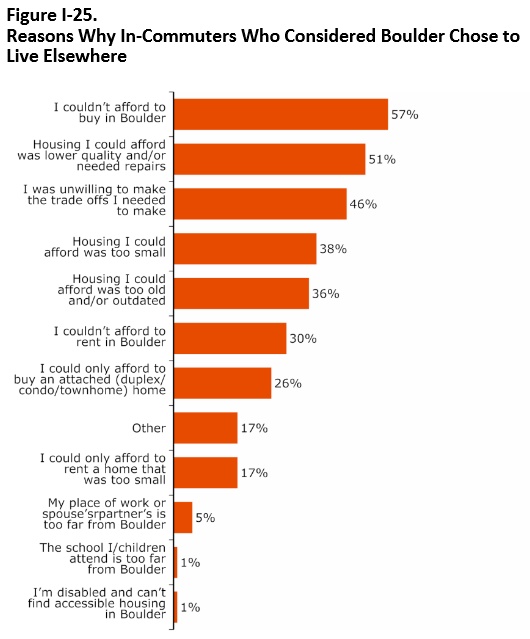At a PLAN-Boulder forum on September 5, 2014 about the city’s Comprehensive Housing Strategy, David Driskell, Director of Community Planning and Sustainability, explained that the strategy’s overriding goal is to expand the economic diversity of Boulder’s residential population beyond what it would be without city intervention. “If we don’t do something, we are going to be a very different community in ten to twenty years,” he declared.

from the 2014 Boulder Community Profile (https://www-static.bouldercolorado.gov/docs/2014-boulder-colorado-community-profile-1-201409191126.pdf)
Driskell pointed out that the prices of detached homes in the city have substantially outpaced the increase in household income during the past ten years. The average sales price of a detached home rose from $419,900 in 2003 to $631,250 in 2013. In contrast, median household income expanded from $73,710 to $82,500 during those same years. The rate of appreciation of the sales prices of attached homes, however, lagged significantly behind that of detached homes. The median sales price of attached homes climbed from $221,660 in 2003 to $266,250 in 2013. Boulder’s housing market is strikingly bifurcated between single-family-detached and multi-family-attached housing, he commented.
Driskell remarked that “we have a lot of wealth-based households” whose income alone would not allow them to afford the houses they own but who are able to do so because of accumulated wealth. He also mentioned that a significant percentage of Boulder’s single-family homes are owned and occupied by people who bought them years ago when prices were significantly lower. He further noted that “a lot of housing [about 30 percent of the rental units] is occupied by students who are not part of the work force.” He asserted that in Boulder, as in neighboring communities, developers during recent years have been extremely reluctant to build condominiums due to fear of liability under Colorado’s construction defects law. Instead, they have been constructing rental apartments.
Driskell observed that nearly all of Boulder’s lower-priced, “affordable” housing is “attached products built in the 1970’s,” as well as dwelling units that are part of the city’s permanently affordable housing program [which limits re-sale prices].
Driskell said that the Comprehensive Housing Strategy has fallen well behind its original schedule due the disruptive effect of the September, 2013, flood. Most of the work so far has been what Driskell called “foundational”—in other words, the collection of information. As part of this phase, the city hired BBC Research & Consulting to conduct a housing choice survey of about 3,000 individuals, including in-commuters, non-student residents, and student residents.

Incommuter household profile (from https://www-static.bouldercolorado.gov/docs/BBC_-_Housing_Choice_Survey_and_Analysis-1-201405131151.pdf)
Among the most notable findings of the survey was that the age profiles, racial and ethnic identities, and economic profiles of the in-commuters are very similar to those of city residents. Indeed, the incomes of the in-commuters are in general slightly higher than the incomes of the city residents. The most remarkable differences between the two groups are that significantly more in-commuters than residents have children, and that in-commuters are 1.5 times more likely to live in a single-family home than residents.
The reasons the in-commuters cited for choosing to live outside Boulder were varied, but the predominant one was a preference for a larger dwelling unit and yard in neighboring communities than one could obtain for the same price in Boulder.

Incommuter responses (from https://www-static.bouldercolorado.gov/docs/BBC_-_Housing_Choice_Survey_and_Analysis-1-201405131151.pdf)
Fifty-six percent of the in-commuters claimed that they would consider re-locating to Boulder if the right type of housing were available at the right price. Of those 56 percent, 78 percent said that they would consider relocating for a small, detached, single-family house, 54 percent for a townhouse, and 43 percent for a duplex, triplex, or fourplex. Most indicated a strong desire for a private or shared garden or yard.
“Are there things the city can do that would affect the market outcomes,” Driskell asked, in order to attract a significant number of in-commuters to reside in Boulder.
Driskell said that the next phase of the strategy is “idea generation.” He said he expected the city to convene a symposium in October to seek what he called “creative ideas” from representatives of municipalities around the country that have experimented with housing programs. He also said that the city will form several “working groups” of local people to consider proposals concerning various housing sub-topics. Driskell noted that at its September 2 study session on the Comprehensive Housing Strategy the City Council asked for broader public participation in this phase than the staff had contemplated. He rejected the notion of conducting a community survey at this point to determine what sort of additional housing the current residents of Boulder would prefer to have built.
Driskell also estimated that the city currently has 102,500 jobs, compared to 102,420 residents. Thus, Boulder’s ratio of jobs to population greatly exceeds the 2/3 ratio that prevails in the Denver metropolitan area. Fifty-nine percent of the work force commutes from other areas, and 41 percent lives in Boulder, Driskell said.
Driskell, however, discouraged suggestions from some audience members that the city could and should strive to lower its jobs-to-population ratio—in part to reduce the pressure on the housing market. “We are not going to have any magic balance,” he claimed. He contended that regulating the number of jobs in the city would be a very complicated challenge, and noted that the city lacks any direct control over CU, which plans to expand its student body and work force. He also observed that, unlike many other municipalities, the city makes no effort to attract employers to locate here.
More information about the Comprehensive Housing Strategy is available on the city’s website.



 (4 votes, average: 4.00 out of 5)
(4 votes, average: 4.00 out of 5)